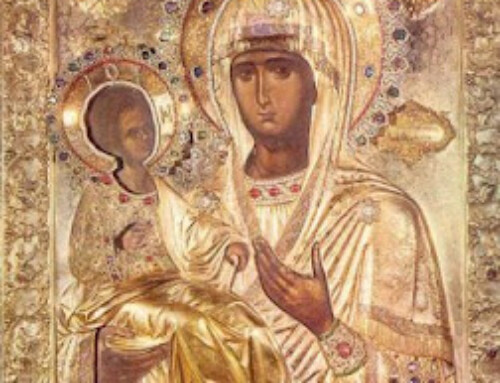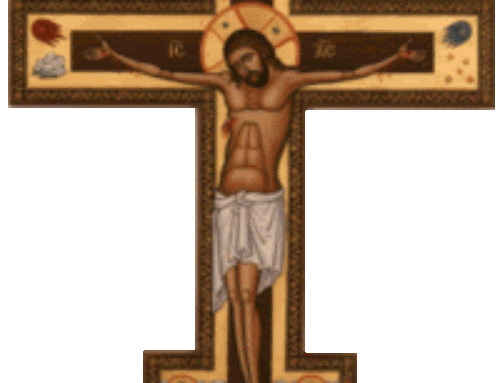Word Magazine September 1960 Page 3/28
By Archpriest Leonid Kolchev
For a long time the Cross served as the instrument of a shameful punishment, exciting fear and disgust among people, but from the time that Christ sanctified it by His Blood, it became an object of pious respect and veneration for all Christians. However, this did not become universal at once. The very life-bearing Tree on which the Lord was crucified laid in the ground for many years until it was revealed to the world in a miraculous manner.
Whenever the waves of persecutions directed against Christians died down and they emerged, tormented and bloodied, from the catacombs and caves into God’s light, signing themselves with an extensive sign of the cross, then it was that Konstantine the Great, who more than once had felt the power of the Cross, decided to find the same Tree to which the Body of Christ had been nailed. His eighty-year old holy mother Helen took upon herself this sacred task. Arriving in Jerusalem she spent much time and means to discover exactly where the Cross of the Lord was hidden. She managed to establish the fact that soon after the Resurrection of Christ the Jews had deeply filled up the crag of the Lord’s tomb, since it was a living monument of their rejection of the Lord. There, covered by rocks and all sorts of refuse, was discovered the life-giving Tree of Christ with the crosses of the thieves. In order to weaken the respect of the early Christians towards the holy places, in later times the heathen had placed idols upon Golgotha, had built a temple in honor of the shameless goddess Venus. Later it was found that a certain old Jew, Judas by name, on the basis of written family traditions, knew exactly where the Cross of Christ was hidden. For a long time he did not agree to reveal his secret and only forced by hunger and poverty did he lead the Empress Helen and Patriarch Macarius to Golgotha. Pointing to the exact spot, he said “Here you will find the Cross of your Christ.”
— With piety, burning with impatience, the people started to work, animated by the sweet-odor emerging from the earth at that spot. Sure enough, soon there were found three well-preserved crosses which were exactly alike by their exterior shape. It was therefore impossible to ascertain which of them was the Cross of Christ, since the board with the inscription J.N.K.J. was lying separately. The perplexity was dispersed by Patriarch Macarius who said: “If Providence did not favor the leaving of the Lord’s Cross in the ground, will it allow it to remain unknown now? Will it allow us to give honor to a robber’s cross in place of the Lord’s Cross? God Himself will show us the Cross of Our Saviour.” With these words he commanded that the crosses be taken to the home of a grievously-ill woman. Here, after fervent prayer, he placed on her the crosses, one after another. The first two did not show any effect on the sick woman, but as soon as he placed on her the third cross — the ill woman immediately felt herself healed and arose from her bed. Giving praise to God, everyone unanimously recognized this wonder-working cross as the Lord’s. It was pleasing to the Providence of God to reveal new glory for the life-hearing Tree. Just at that time a dead man was being carried to burial past the house of the woman who had been healed. Filled with faith, the Patriarch, in the presence of the Empress and a great multitude of people, stopped the sorrowful procession and began to lay the crosses upon the dead man. And the same one of them which gave health to the sick woman, resurrected the dead man, to the indescribable joy of the surrounding populace. All those present could not be controlled in their desire to venerate the precious Cross and kiss it. Since this was impossible because of the tremendous gathering of people, Patriarch Macarius stood upon an elevated place, and with help raised the Cross high in the air several times so that it could, at least, be seen by all. Bowing down to the ground with piety, the people cried out: “Lord, have mercy!” It is from this festive act of the raising or elevation of the life-giving Cross of the Lord that today’s feast received its name. In this glorification of Christ’s Cross, His very enemies were forced to give it veneration. Judas, with whose help the Lord’s Cross was found, received Holy Baptism with the name Cyriacus and, little by little, being elevated in the degrees of the Priesthood, later occupied the place of Patriarch of Jerusalem, and later still was made worthy of a martyr’s crown.
What is the later history of the Cross of Christ and where is it now found?
In the year 614 the Persian King (Shah) Khosroes captured Jerusalem and along with other treasures abducted the Tree of the Cross. After 15 years when the Persians were defeated, the Cross was returned. At the triumphant meeting of the returned Cross the Emperor Heraclius, himself decided to bear this treasure from the Mount of Olives to the Church of the Resurrection. At the gates of Golgotha, however, some invisible force stopped him and the more he tried the stronger was the power that held him back. Then it was revealed to the Patriarch in a vision that it was not right for the Emperor to go in such majesty and brilliance where the Savior Himself, carrying His own Cross, went in such poverty and humiliation. The next day, having divested himself of his footwear and extravagant raiment, dressed in simple clothing the Emperor took the Cross upon his own back and without any hindrance carried it to the Church. This was 14 September of the year 629. Later this Cross was taken apart in particles by the Faithful and today there is not, it would seem, any country where particles of this most precious sacred object is not preserved in churches and even by individuals.
And Christians of the whole world piously honor this life-bearing Tree. “It is worthy and right to venerate Christ’s Cross.” says Saint Demetrius, the Metropolitan of Rostov, “for through this blessed Tree was death slain and life granted.” “This sign,” teaches another prelate, John Chrysostom, “both in former and present times opened closed doors, removed the power of ill-bearing substances, made poison ineffective, and healed the mortal bites of beasts.”
Come, faithful, let us bow to the Cross of the Lord lying before us and, following the example of the ancient Christians, let us say with compunction: Lord, have mercy! Through the might of the precious and life-creating Cross, save us sinners. Amen.*)
*) A sermon by Archpriest Leonid Kolchev. Translated by D.F.A.






